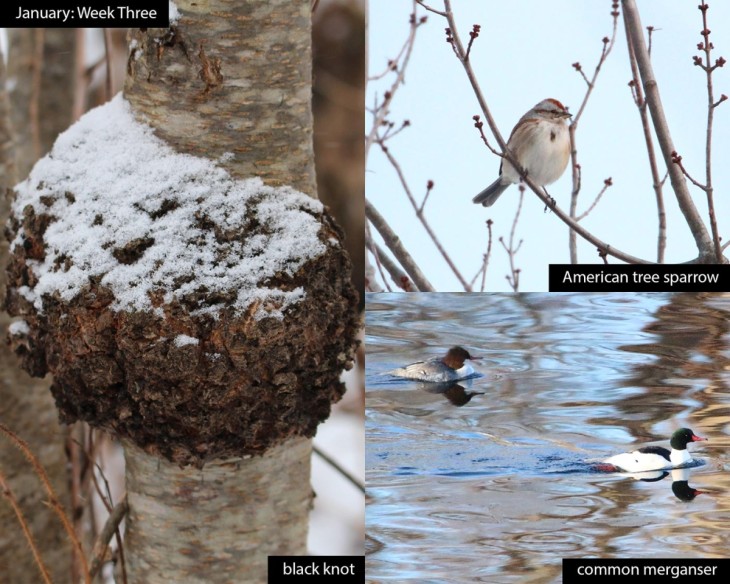This week in the woods, we observed indications of black knot, the fungal disease caused by Apiosporina morbosa or Dibotryon morbosum and only infecting species in the genus Prunus. It shows up on a trunk here, where it resembles and was initially mistaken as chaga, but most often manifests on twigs and branches, growing along and encircling the affected limbs. The blackened, tumor-like growths cut off nutrient transmission and can cause tree decline and death, especially if they girdle a trunk.
A far-northern species that nests in the Arctic scrub and tundra near the treeline, the American tree sparrow winters well south of its breeding range. While some granivorous birds, such as pine siskins and crossbills, have irruptions dependent on food supply, the American tree sparrow’s presence in the continental United States seems dependent on weather, with the bird less abundant during mild winters. Logic suggests this one-ounce sparrow, with a relatively low ratio of mass to surface area, would generate little heat, cool rapidly, and cope poorly with the cold. However, these “Little Brown Jobs” have effective strategies for facing low temperatures. First, they fatten up. They forage diligently in small flocks for catkins, grass, and berries, will beat seeds loose with flapping wings, and continue to search for food straight through snowstorms. Like other passerines, they have among the highest metabolic rates of any vertebrates and maintain a base temperature over 100 degrees Fahrenheit. When at rest, they shiver, their large flight muscles producing a prodigious amount of heat. During the winter, the birds’ feathers increase in volume by 50 percent, both in a smooth upper layer and a hidden down layer. On cold days, they fluff up these feathers to trap air and enhance insulation in a process called piloerection (in humans, we give it the avian name “goosebumps”). At night, sometimes roosting communally or under insulating snow, tree sparrows go into torpor, lowering their body temperature, reducing heat flow to the outside air, and saving energy they can put to good use in seeking sustenance during the day.
With so much time spent in water, ducks benefit from an additional set of winter adaptations. On top of especially large fat reserves, they have preen glands at the bases of their tails. To waterproof themselves, they spread oil from these glands over their dense feathers with their beaks. In another adaptation, known as countercurrent blood flow, warm, oxygenated, arterial blood from ducks’ bodies passes close to cold, deoxygenated, venal blood from their feet, facilitating heat exchange with maximum efficiency. (For more on the circulation system’s role in animals’ winter survival, see Douglas Facey’s 2023 Outside Story article.) Even among cold-tolerant ducks, common mergansers have a reputation for hardiness. The holarctic diving ducks leave their summertime lakes in the fall only once a skim of ice begins to form, and winter only as far south as needed to find ice-free water. They return north as soon as the ice thaws and open water in their breeding territory becomes available. We see them year-round in New England (though seldom the same individuals in summer and winter) and in the Upper Valley mostly along clear portions of the Connecticut and White rivers during the winter.
What have you noticed in the woods this week? Submit a recent photo for possible inclusion in our monthly online Reader Photo Gallery.



Discussion *